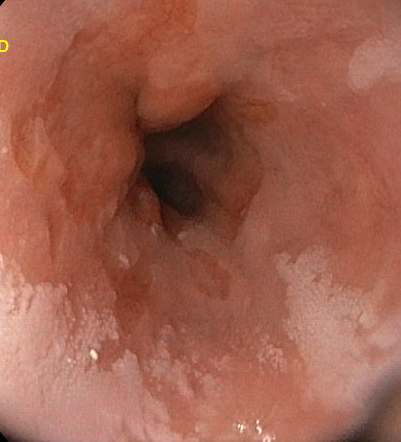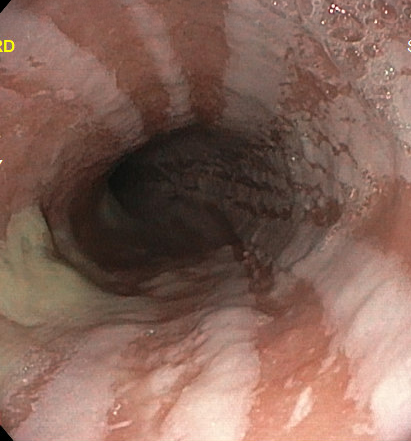Tuesday Poster Session
Category: Esophagus
P4988 - A Rare Case of Esophageal Parakeratosis Found During Endoscopic Evaluation of Dysphagia
Tuesday, October 28, 2025
10:30 AM - 4:00 PM PDT
Location: Exhibit Hall
- TT
Tenzin Tseky, DO
Arnot Ogden Medical Center
Elmira, NY
Presenting Author(s)
Tenzin Tseky, DO, Paige Robinson, DO, Sheel Clerk, DO, Sabrine Sleem, DO, Imtiaz Shah, MD, Gurtej Dhaliwal, MD, Gary Valvano, DO, Bruno Mazza, MD
Arnot Ogden Medical Center, Elmira, NY
Introduction: Esophageal parakeratosis is a relatively rare finding on upper gastrointestinal endoscopy of unclear clinical significance characterized by incomplete keratinization of squamous epithelium resulting in retention of nuclei in superficial squamous epithelium. It can mimic neoplastic and infectious processes and has been associated with micronutrient deficiencies (zinc, vitamin B12, riboflavin), tylosis, alcohol use disorder. We present a case of esophageal parakeratosis found during evaluation for dysphagia.
Case Description/
Methods: 76 year old male with past medical history of GERD,vitamin B12 deficiency and macrocytosis in setting of alcohol use dependence, atrial fibrillation on daily low dose aspirin, underwent esophagogastroduodenoscopy (EGD) for further evaluation of dysphagia particularly to solid foods and intermittently to pills. Continuous white linear plaques starting from proximal to distal esophagus were noted during endoscopy, which endoscopist diagnosed as parakeratosis. Esophageal biopsies with special stain for Alcian Blue and Perioidic Acid-Schiff (PAS) confirmed this finding and ruled out dysplasia/neoplastic process. Due to gastritis for which gastric biopsies were negative for H. Pylori and gastric intestinal metaplasia and known history of GERD, patient was started on omeprazole 20mg twice daily and reported improvement in dysphagia symptoms.
Discussion: Esophageal parakeratosis is a relatively rare finding on upper gastrointestinal endoscopy of unclear clinical significance characterized by incomplete keratinization of squamous epithelium resulting in retention of nuclei in superficial squamous epithelium. Although this is largely considered a benign condition classically associated with micronutrient deficiencies particularly with alcohol use disorder, and no surveillance recommendation has been established, there have been associations with esophageal malignancy. Furthermore, it can mimic neoplastic and infectious processes hence careful examination is recommended to not miss a more sinister process. Our patient reported improved dysphagia after treatment of his GERD and gastritis with omeprazole 20mg twice daily. There are some case reports of this being found during evaluation for pyrosis. Additionally, he had a history of B12 deficiency and alcohol use disorder both of which are associated this and there is a case report of esophageal dysphagia in setting of parakeratosis improving with B12 supplementation.

Figure: Esophageal Parakeratosis in Proximal Esophagus

Figure: Esophageal Parakeratosis Extending to Distal Esophagus
Disclosures:
Tenzin Tseky indicated no relevant financial relationships.
Paige Robinson indicated no relevant financial relationships.
Sheel Clerk indicated no relevant financial relationships.
Sabrine Sleem indicated no relevant financial relationships.
Imtiaz Shah indicated no relevant financial relationships.
Gurtej Dhaliwal indicated no relevant financial relationships.
Gary Valvano indicated no relevant financial relationships.
Bruno Mazza indicated no relevant financial relationships.
Tenzin Tseky, DO, Paige Robinson, DO, Sheel Clerk, DO, Sabrine Sleem, DO, Imtiaz Shah, MD, Gurtej Dhaliwal, MD, Gary Valvano, DO, Bruno Mazza, MD. P4988 - A Rare Case of Esophageal Parakeratosis Found During Endoscopic Evaluation of Dysphagia, ACG 2025 Annual Scientific Meeting Abstracts. Phoenix, AZ: American College of Gastroenterology.
Arnot Ogden Medical Center, Elmira, NY
Introduction: Esophageal parakeratosis is a relatively rare finding on upper gastrointestinal endoscopy of unclear clinical significance characterized by incomplete keratinization of squamous epithelium resulting in retention of nuclei in superficial squamous epithelium. It can mimic neoplastic and infectious processes and has been associated with micronutrient deficiencies (zinc, vitamin B12, riboflavin), tylosis, alcohol use disorder. We present a case of esophageal parakeratosis found during evaluation for dysphagia.
Case Description/
Methods: 76 year old male with past medical history of GERD,vitamin B12 deficiency and macrocytosis in setting of alcohol use dependence, atrial fibrillation on daily low dose aspirin, underwent esophagogastroduodenoscopy (EGD) for further evaluation of dysphagia particularly to solid foods and intermittently to pills. Continuous white linear plaques starting from proximal to distal esophagus were noted during endoscopy, which endoscopist diagnosed as parakeratosis. Esophageal biopsies with special stain for Alcian Blue and Perioidic Acid-Schiff (PAS) confirmed this finding and ruled out dysplasia/neoplastic process. Due to gastritis for which gastric biopsies were negative for H. Pylori and gastric intestinal metaplasia and known history of GERD, patient was started on omeprazole 20mg twice daily and reported improvement in dysphagia symptoms.
Discussion: Esophageal parakeratosis is a relatively rare finding on upper gastrointestinal endoscopy of unclear clinical significance characterized by incomplete keratinization of squamous epithelium resulting in retention of nuclei in superficial squamous epithelium. Although this is largely considered a benign condition classically associated with micronutrient deficiencies particularly with alcohol use disorder, and no surveillance recommendation has been established, there have been associations with esophageal malignancy. Furthermore, it can mimic neoplastic and infectious processes hence careful examination is recommended to not miss a more sinister process. Our patient reported improved dysphagia after treatment of his GERD and gastritis with omeprazole 20mg twice daily. There are some case reports of this being found during evaluation for pyrosis. Additionally, he had a history of B12 deficiency and alcohol use disorder both of which are associated this and there is a case report of esophageal dysphagia in setting of parakeratosis improving with B12 supplementation.

Figure: Esophageal Parakeratosis in Proximal Esophagus

Figure: Esophageal Parakeratosis Extending to Distal Esophagus
Disclosures:
Tenzin Tseky indicated no relevant financial relationships.
Paige Robinson indicated no relevant financial relationships.
Sheel Clerk indicated no relevant financial relationships.
Sabrine Sleem indicated no relevant financial relationships.
Imtiaz Shah indicated no relevant financial relationships.
Gurtej Dhaliwal indicated no relevant financial relationships.
Gary Valvano indicated no relevant financial relationships.
Bruno Mazza indicated no relevant financial relationships.
Tenzin Tseky, DO, Paige Robinson, DO, Sheel Clerk, DO, Sabrine Sleem, DO, Imtiaz Shah, MD, Gurtej Dhaliwal, MD, Gary Valvano, DO, Bruno Mazza, MD. P4988 - A Rare Case of Esophageal Parakeratosis Found During Endoscopic Evaluation of Dysphagia, ACG 2025 Annual Scientific Meeting Abstracts. Phoenix, AZ: American College of Gastroenterology.
